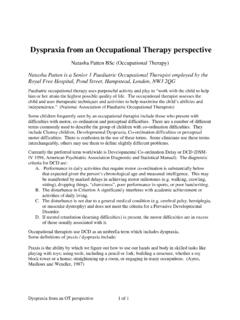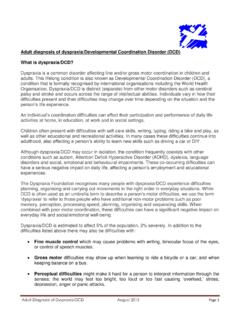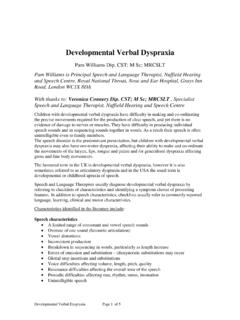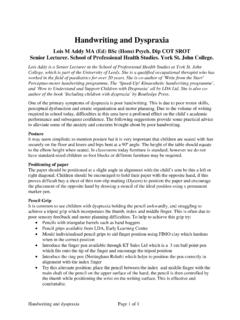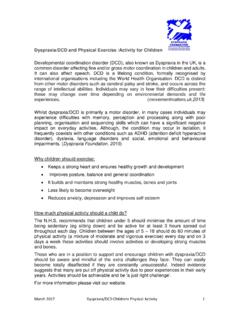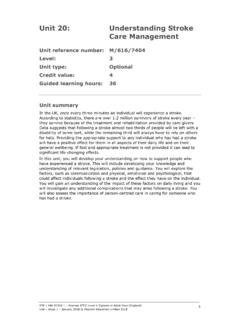Transcription of Tactile Defensiveness - Dyspraxia Foundation
1 Tactile Defensiveness Information for Parents and Professionals By Sidney Chu, MSc, SROT, OTR Introduction The Tactile system is our sense of touch through different sensory receptors in our skin. It is through the Tactile system that we first receive information about the world when we come out from the womb environment. The ability to process Tactile information effectively allows us to feel safe and form bonding with those who love us. It contributes to our social and emotional development. One important role of our Tactile system is its protective function that alerts us when something is unpleasant or dangerous.
2 For some children, this function of the Tactile system is not working normally. They may perceive most touch sensations to be uncomfortable or scary and react with a flight-or-flight response. We call this condition Tactile Defensiveness , which was first identified by Dr Ayres, an American Occupation Therapist around the 1960s. What is Tactile Defensiveness ? Tactile Defensiveness (TD) refers to a pattern of observable behavioural and emotional responses, which are aversive, negative and out of proportion, to certain types of Tactile stimuli that most people would find to be non-painful (Royeen & Lane, 1991).
3 It is a type of Sensory Integrative Dysfunction, which is the brain s inability to process and use information through the senses. Children whose Tactile systems give inaccurate information are frequently in the state of red alert . Casual contracts within an ordinary daily environment could cause extreme reactions that may be interpreted as bad behaviours. They may react be whining and clinging (fright), or lashing out (fight) and running away (flight) (Trott, 1993). The neural disorder that causes a child s Tactile Defensiveness does not necessarily affect the child s learning ability.
4 However the discomfort and behavioural reactions caused by this disorder does interfere with the learning process. Very often the child is emotionally insecure (Ayres, 1979). Although not well understood, TD has been recognised for many years as a Hypersensitivity or hyper-responsivity to touch in a variety of populations (Baranek and Berkson, 1994). For example, it has been identified in children with specific learning difficulties (Ayres, 1964, 1972), learning disability (Kinnealey, 1976), autistic spectrum disorder (Ritvo, Ornitz and LaFranchi, 1968: Ayres and Tickle, 1980 and Grandi, 1984), and other developmental disorders (Larson, 1982).
5 1It is important to note that TD and developmental Dyspraxia are two separate conditions. Occasionally, child could suffer from both conditions at the same time. We call this situation co morbidity. More commonly, a child with TD may be misdiagnosed as a child with developmental Dyspraxia . There is some confusion among a number of professionals about the understanding of the two conditions. Clinically, it is extremely important to make an accurate diagnosis, as the treatment for TD is different from that for Dyspraxia .
6 Behavioural Indicators of Tactile Defensiveness Children with TD are usually hyperactive and distractible. They over-react to Tactile stimulations so that most people do not particularly notice, or at least are not bothered by it. However, it is important to note that children with TD will get involved in certain Tactile activities if they are in control. They will also actively seek out a large amount of muscle stimulation and firm touch stimulation as a means to reduce the level of hypersensitivity. They may frequently and consistently present some or most of the following behavioural features (Ayres, 1979: Larson, 1982: Royeen, 1985: Royeen & Lane, 1991).
7 Avoidance Responses to Touch Stimulation Avoidance of certain styles or textures of clothing ( scratchy or rough); or conversely an unusual preference for certain styles or textures of clothing ( soft materials, long sleeved shirts) Avoidance of contact with other children, preference for standing at the end of line during assembly, staying at the edge of a group during story time etc. Avoidance of anticipated touch or from interactions involving touch, tendency to pull away or avoidance of touch to the face Avoidance of play activities involving Tactile materials ( sand, finger paints) or body contact, with a tendency to prefer solitary play Avoidance of going barefoot, especially in sand and grass (could result in tip-toe walking)
8 Avoidance of a crowded environment, likes to stay under the table, behind the settee or under the staircase 2 Aversive Responses to Non-Painful Touch Aversion or struggle when picked up, hugged or cuddled Aversion to certain daily living tasks, having showers, cutting fingernails and hair and face washing Aversion to dental care and/or brushing teeth Aversion to being handled during daily activities, changing nappy or clothes, cleaning nose or face Aversion to being approached from behind.
9 May rub skin or scratch area being touched Emotional Responses to Touch Stimulation Becomes anxious and distressed when being physically close to people, during assembly, inside the dining hall, etc. Refusal to participate in certain social activities, going to a party or supermarket Responding verbally or with physical aggression to light touch to arms, face or legs, lashing out Objection, withdrawal or negative responses to touch contact, including that encountered in the context of intimate relationship even in a friendly or affectionate manner.
10 A tendency to prefer to touch rather than to be touched. Some children may seek firm touch in order to modulate the level of Defensiveness . It is important to note that children with TD quite often present hypersensitivity to other sensory stimulations, movements, sights, sounds. When a child presents hypersensitivity to more than one sensory stimulus, we call this Sensory Defensiveness . Theoretical Explanation of Tactile Defensiveness Different theories have been proposed to explain this specific Sensory Integrative Dysfunction over the years.
